From internal pipelines, drains are transported by external ...

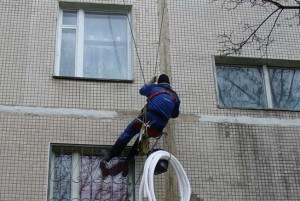
Sealing interpanel seams - One of the most important construction operations, because it is the joints that represent the weakest point. In addition, over time, defects may appear in them and then, at the request of residents and the housing maintenance organization, re-processing is performed.
Sealing interpanel seams is the process of filling the voids formed between the plates. If this procedure is ignored, then moisture, cold air will penetrate through the cracks, condensation will form. By eliminating such defects, you not only insulate the room, but do not allow dampness and mold to get into the housing. And the latter is very harmful to our health. In addition, peeling of wallpaper, blackening of walls and other troubles is possible, so that the aesthetic side will also suffer.
Sealing is done not only at the construction stage, it is necessary to periodically restore the seams.

What are the causes of depressurization? First of all, mistakes in the design and construction itself. In addition, it is very important to choose the right materials. For example, a combination of gaskets with different degrees of elasticity will not give the desired result. If you decide to use special self-adhesive tapes, then you should not give tension, it is better when they sag a little. Plus, an additional adhesive undercoat should be used from below. This will minimize stress inside the sealant.
Today, there are many sealants for interpanel seams, and they have a different look. Special mastics, silicones and are very popular. The choice of a material depends on the width of the cavity. If the seam is narrow, then you should give preference to silicones, but wider and deeper grooves are processed with mounting foam. It is best to use a non-expandable one, otherwise you will have to crop the protruding parts. And this is already unnecessary labor, and taking such a step is not always easy, especially when it comes to outdoor work on the upper floors.
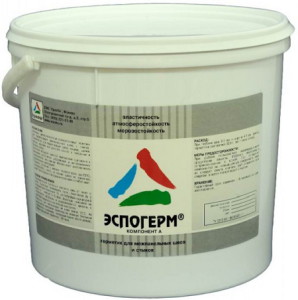
In addition, the foam is afraid of ultraviolet rays, so it must be closed, the finish layer must be in the same plane with the plates, that is, it will be necessary to cut out the cured composition with a small depression. The use of expandable material is allowed only when working with very large seams. In this case, it is applied in two layers.
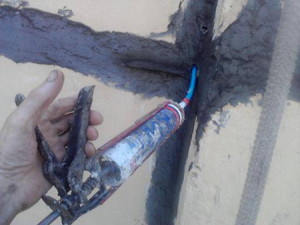
Special sealing tapes have also found their application. They are advisable to apply even at the construction stage. The technology is simple - lay a strip of sealant on the joint of concrete elements, and under the pressure force of the upper part, the material is pressed and the connection is reliable. Now you can not be afraid of drafts, precipitation, or other vagaries of the weather.
B is divided into primary and secondary, i.e., during the construction of the building and during the repair activities. When carrying out primary work, a sealant is first laid in the joints, or they are processed with special materials, and then a layer of waterproofing follows. It is very important that all components are resistant not only to precipitation, but also to temperature differences. Re-processing joints in the house is recommended no later than 7 years from the date of construction. The fact is that absolutely any mastic has a life of no more than 15 years.
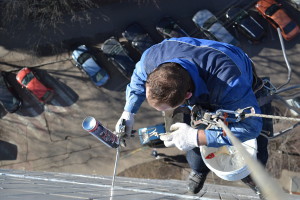
Secondary sealing technology differs depending on the condition of the joints. If they do not have significant defects and the mastic has retained its properties, then it is quite enough to simply replace the outer layer. But when the joint is badly damaged, then all old materials should be completely removed and replaced with new ones.
Carrying out such work, you should adhere to some rules. In the event of defects in horizontal joints, joints of at least three vertical rows are subject to sealant treatment. If the integrity of the vertical seam of the longitudinal facade in the house is violated, then all vertical cracks and adjacent horizontal ones will have to be repaired. And when it is necessary to carry out restoration work from the front side, do not forget about all the joints between the longitudinal walls and the end panels, as well as the entire facade.

In addition, the mastic should be sufficiently plastic, because interpanel seams in the house can slightly change their sizes due to shrinkage, creep of concrete, thermal expansion or under the influence of various loads. If the material is too hard, then depressurization will occur and will have to carry out restoration work again. Also, the mastic should be laid in a layer at least 2 times thinner than the joint, at least for gaps with a mouth greater than 1 cm.
Now it's time to study the technology for sealing interpanel seams. Let’s try to make an instruction that is understandable even for dummies, although it should be noted that professionals should be engaged in such work. Firstly, they have special equipment to work at height. Secondly, our comfort and economy depend on quality, since the room will produce less heat in winter, and even health, because the negative effect of fungi and mold on the human body has long been proven.
In order to seal the interpanel seams as productively as possible, you should prepare all the necessary equipment. A metal brush, spatula, vacuum cleaner, sponge, spatula, broom will come in handy. From the material you need to purchase the sealant itself, insulation, foam, sand and cement. Next, it is very important to prepare the room. All furniture, if we are talking about a residential building, or other items are taken out so that the room is empty. Then you should remove the old coating from the walls, so we will free access to the seams.
Having removed large elements, we clear the room of dust, in this case a vacuum cleaner is useful. Carefully go through all the joints. If we are talking about the secondary sealing of panel seams, then we remove the old material from them. Do not forget to carry out wet cleaning after this, otherwise dust from the air will settle in the most inappropriate places and this will negatively affect the quality of work. Then we wait until the treated surface dries, and then degrease it with a special tool.
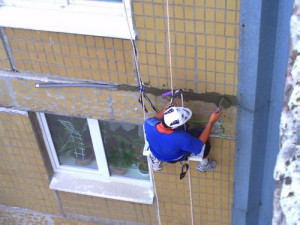
The key to success is high-quality insulation of the cavity. If the seams are large enough, then they are first filled with foam. Until it has completely hardened, a layer of thermal insulation is laid, which most often looks like a very dense hollow tube. Due to the excellent elasticity, installation problems will not arise.
There is another sealing scheme, the "warm seam". In this case, the insulation is laid first and only then it foams. Thanks to this combination, the cavities are reliably filled, and drafts, and especially moisture, have no chance of penetrating the room. If you suddenly got the wrong foam or applied too much, then the excess should be removed. At the same time, the gap should be such that it also fits mastic and topcoat.
Now it's time for the mastic to seal the interpanel seams. Remember, the material must have good elasticity, so do not skimp and purchase only high-quality goods. The mixture is applied gently, in a continuous line along the entire length of the seam. It is possible that you will need a special mounting gun. So, having inserted the cylinder into the body, slowly push the trigger. It is better to begin to process distant cavities to fill your hand. True, the top layer will go from above, so more attention should be paid to reliability than to appearance. The sealant can be easily removed until it hardens, just wipe it with a damp cloth.
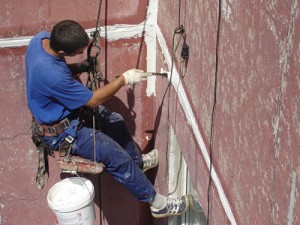
To protect the seam from the negative effects of the environment, when it comes to outdoor work, it is necessary to treat it with an additional cement-sand mortar. But only after the mastic completely hardens. Indoors, the walls are usually plastered, and a special mesh is applied to the joints. Moreover, it is better not to save on the latter, otherwise cracks will form on the plaster. In principle, the sealing of interpanel seams is carried out approximately the same when using any of the materials. However, do not forget to read the instructions on the package, in it you can also find a lot of useful information.
One of the most important high-altitude maintenance work on prefabricated buildings is the sealing of joints. Many reasons can lead to depressurization of joints: non-compliance with technologies during construction, temperature and sedimentary deformations, destruction and aging of materials previously used for sealing. This primarily affects the moisture insulation and thermal insulation of apartments in such a panel building.
First of all, pay attention to such disadvantages as:
If you notice at least one of the above disadvantages, then in your house the tightness of the structure of existing interpanel seams is broken, the seams can be tightly insulated, or completely destroyed by the operating time and atmospheric phenomena. Often depressurization of joints occurs both outside and inside the building. In this case, sealing joints, joints between the panels will be the most reasonable solution.
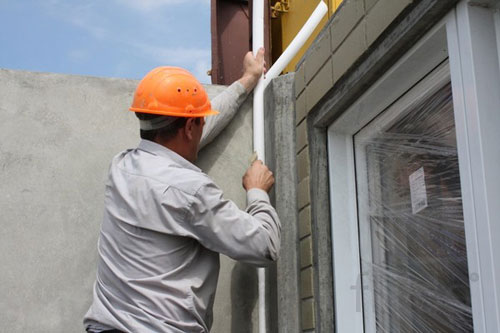
Often sealing interpanel joints can be carried out using such ineffective methods as:
Often, sealing interpanel seams is done using Vilaterma, which has several advantages:
Depending on the thickness of the seam, the sizes of such a heater are also selected. Wilaterm can be solid or hollow inside. Sealing of interpanel seams should be carried out using a hollow insulation material, because it differs in a more dense structure, elasticity and is not so demanding on conformity in diameter. Hollow tubular insulation fits easily into the seam. In this case, the main thing is to dock it well along the length and not damage it during installation.

The thickness of such a insulation tube is selected slightly more than the size of the seam (10-30%). This material cannot be cut lengthwise, since in this case it will quickly lose its properties. Using a wooden spatula, Vilaterm is laid in the seam, leaving 1-3 mm. Then mastic is applied to seal the seams of the facade.
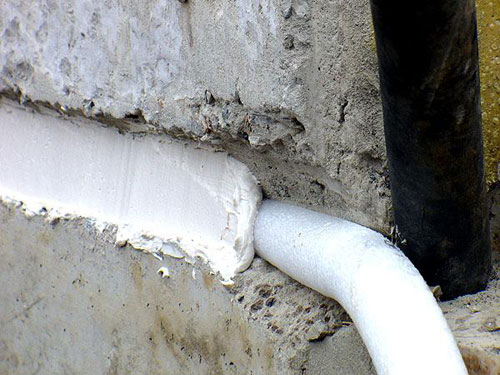
This method of sealing joints has its drawbacks. If such a heater was poorly sealed, then it can absorb moisture, begin to freeze and then collapse. In addition, the seam between the panels does not have a completely regular geometric shape, so it’s almost impossible to lay Vilaterm: it is pinched in one place, and laid too loose in others. Therefore, moisture continues to penetrate the seam and it is much more difficult to find a leak after such sealing.
In some cases, sealing joints in a panel house is done using polyurethane foam. It is poured into the seam, where the foam expands and fills all the voids, preventing leaks and drafts from entering the room. Hardening foam hardens within a day.
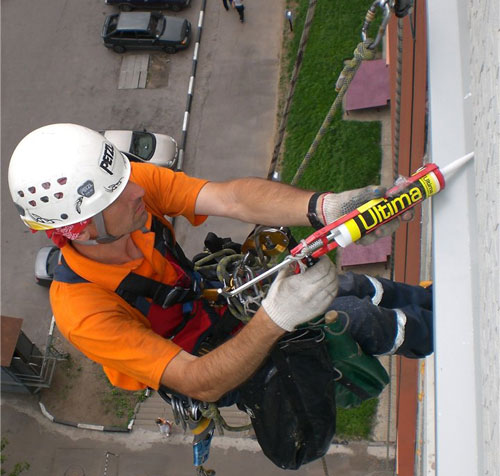
Foam is also an excellent heat insulator. This method is perfect for sealing the seams inside the apartment.
But there are also disadvantages to this method. Since part of the mounting foam protrudes outward of the seam, it should be cut off. It is necessary to cut off the surface strong layer, leaving open the fragile and porous inner part, which is destroyed under the influence of the sun and precipitation.
Currently, the most effective sealing of interpanel seams in a combined way, the so-called warm seam. This method provides:
Thanks to this, a dry and warm seam is obtained for many years.
Competent and proper sealing of interpanel seams allows you to increase the temperature by 3-4 degrees and get rid of the negative effects of moisture. Therefore, if your walls blacken, fungus and mold appear, the wallpaper exfoliates, it is the sealing of the seams that will be the rational solution.
Sealing joints in a panel house can be done in several ways. The choice of a specific technology depends on the condition of the building and the goals set. Our company provides a full range of services related to the repair of interpanel seams, namely:
Opening and stripping of the seam;
Removing the remains of the old sealant from the facade;
Filling the seam with mounting foam;
Laying insulation "Vilaterm";
Covering the insulated seam with mastic.
|
See the technology of work: |
Sealing of “closed” joints of external wall panels vulcanizing sealants with or without polyurethane foam. |
|
The joints of the “closed” type are sealed with vulcanizing mastics / sealants on the basis of Vilaterm foam pads installed in the “dry” joint. If necessary, voids can be foamed with Illbruck PRO 70 polyurethane foam. Filling the mouth of the joint with mastic is done with a spatula. With a large opening of the joint, the mastic is applied with an approach to the panel of external walls of up to 3 cm. |
|
|
Temperature not lower than -20 ° C in the absence of precipitation. The thickness of the applied sealant layer is at least 3 mm. |
|
|
Vulcanizing mastic / sealant: Akatamast, Oksiplast, Elastosil, Sazilast. |
|
|
Universal spatula. |
The final price for the work will depend on the number of running meters on which the sealing should be made. You can find out the exact cost of the work thanks to the free service to call the measurer, by using a telephone consultation or by calculating yourself using this price list:
|
Name of works |
Units measuring |
Price, rub.) |
|
1. Primary joint sealing with insulation |
||
|
2. Secondary sealing |
||
|
3. "Warm seam" (opening or drilling holes in a concrete seam, foaming, sealing) |
||
|
4. Sealing of stained-glass windows, anti-aircraft lamps |
||
|
5. Sealing window joints |
||
|
6. Sealing of folds of a metal roof |
||
|
7. Sealing of peaks |
||
|
8. Sealing slabs on the technical floor (without replacing the roofing) |
||
|
9. Sealing of slabs on the technical floor (with replacement of the roofing) |
1. Housing and communal services "Serpukhov". Sealing joints 3,200 meters
2. Sealing 5,050 linear meters - "Warm seam"
3. Sealing "Warm seam without opening" - 7 750 m.
You leave a request
Is free
After 15 minutes
We contact you
Is free
On the day when
assigned
a meeting
We conduct inspection of the place of work, make measurements
Is free
In 2 hours
after meeting
We provide you with estimates for high-altitude work
Is free
Next
day
We conclude an agreement
Prepayment
In agreed
deadlines
We perform all turnkey work
Final settlement
You get fully completed high-altitude work on time and at
agreed upon price.
Our company guarantees the repair of panel joints in accordance with all technical instructions adopted in the Russian Federation. In their repair and construction activities, specialists are guided by the main regulatory documents, such as:
SN 420-71 “Building norms and rules for sealing interpanel seams”;
BCH 19-95 “Instructions on the technology for sealing butt joints of panels of the outer walls of residential buildings”;
VSN 40-96 “Instructions for the execution of work on sealing joints of external walls and window blocks”;
TR 94.10-99 “Technical regulations for work on sealing joints of external building envelopes”;
TR 94.07-99 “Technical regulations for work on sealing joints of external building envelopes”;
44-03 TK (routing) "Sealing the joints of external building envelopes";
VSN-119-75 “Instructions for sealing joints during the repair of prefabricated buildings”;
TR 95.07-99 "Technological regulations for sealing joints of external building envelopes";
VSN 170-80 “Instruction Sealing of vertical and horizontal joints of panels of external walls of a series”; P44 / 16
VSN 17-94 “Instructions on the mechanized technology of thermal insulation of joints of exterior wall panels of residential buildings with phenol-formaldehyde foam”.
Following these standards, the company has developed its own methods for performing external sealing of joints, thanks to which our customers have been receiving a high-quality and quick solution for warming expansion joints for more than 10 years. Experienced industrial climbers who work in the state, the use of the latest equipment and construction equipment are the advantages that make it possible to call the group of companies Diamand LLC a leader in their industry. Be convinced of it and you!
Over the years panel construction of buildings, many series of designs for residential buildings and non-residential buildings were created, which differ structurally. But technologically, they all have common pros and cons during their operation. The most significant link in the chain of maintenance work of the panel structure is the suture connection at the joints of structural elements. The fact is that when the building is upset, an insignificant, but a change in geometry, which manifests itself in the form of cracks at the joints sealed with stucco, inevitably occurs.
The house is “breathing”, and this is a completely natural and normal state, but it creates a lot of unpleasant problems to eliminate cracks. It is clear that the panels can slightly move relative to each other, and all displacements inevitably add up at the seams, as the most weakened place. In this case, the sealing of the joints is violated, the essence of which is to putty the empty spaces between the panels.
Reinforcements with reinforcement in the practice of repairing the first series of panel five-story buildings were experimentally carried out, but this led to the emergence of two new factors: cracks in the panel itself, and through-wall freezing. Seams should have a sufficiently plastic seal. Until the seventies of the 20th century, tow was used in the body of a concrete structure, with external protection against precipitation in the form of a solution and bitumen varnish. Later, this filler was abandoned in favor of such material as Vilaterm.
So the sealing of panel joints is carried out using new technology.
Foamed polyethylene perfectly retains heat. But plasticity of such a material is much more advantageous. Over time, the technology of using new materials improved, and now, when repairing to repair joints of panel joints, there is a choice, depending on what dimensions the distance between the plates has, how much the interface should be protected from weather factors and the accessibility of the work site itself.

Since the sealing and sealing of joints in a prefabricated house is important for improving thermal insulation and waterproofing, the main materials during work are: Vilaterm and polyurethane foam. Such materials can be combined quite well when filling up large cavities, where Wilaterm is the filler and polyurethane foam is the sealing material. If the location of the cavity does not have direct access, it is usually filled with polyurethane foam or foam through the holes in the witherm.
In the event that repair work was carried out previously with a sufficiently high-quality external protection, but in this process the intersutural cavities were preserved, for which it is necessary to warm the interpanel seams in prefabricated houses, technological holes are made, 3 - 4 per meter of seam.
Sealing joints in a panel house, the technology of sealing joints is now not particularly difficult.
Through special holes, cavities are filled without opening the old seal, followed by applying a protective layer of mastic. Similarly, using technological windows and openings, work is carried out to seal the interfloor ceilings inside the building.
Without going into technological subtleties, we can say that, depending on the specific condition of the mating panels, the specialist technologist of our company chooses the most economical and high-quality method of eliminating voids, based on the fifteen-year experience of the enterprise in this area, and the experience of using new technologies in house building.
The owner of the building or apartment is always interested in maintaining the quality condition of the building, and therefore seeks to protect it from exposure to water, sun, temperature extremes and other climatic factors. There are several technologies for sealing interpanel seams in prefabricated houses and insulation of panel seams
The most suitable in this regard will be the work carried out by our company. by technology of a warm seam.

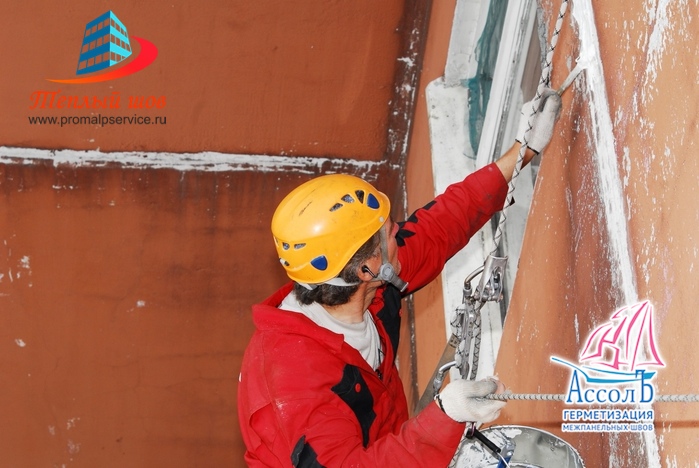
Technology "tight seam"
This method is a more progressive version of the methodology for sealing joints of panel structures. This technology involves, in addition to protection from moisture, filling the seams with a full-bodied cord of foamed polymer from the Wilaterm assortment.
High-quality sealing of interpanel seams in prefabricated houses is carried out using material from Macroflex, Penoflex, etc. Such elimination of voids in the seams is possible if the cavity at a long distance has the same width and there are no deep chips. If this requirement is not met, then the tube will not close the cleft or significant expansion of the cavity at the junction of structures, as a result of cracks, repair of interpanel joints in panel houses in this case will not bring the proper result.
Since the change in the geometry of the joints is usually associated with the shrinkage of a newly built building, the density of the fill of the joint using the "tight joint" technology is usually provided during scheduled repair work, or at the request of the customer at structures with a long term of operation.
If the laying of the tube from the wilaterm is not flattened enough to hold in the seam, it is filled with polyurethane foam.
The width of the cushioning materials is selected with an allowance of 10 - 15% of the size of the seam at the widest possible location of the seam, followed by sealing against moisture.
Technology "Warm seam"
"Warm seam" in its classic version is performed by the production of work in the following sequence:
Preparatory cleaning of the surfaces of the future seam;
Processing of joint surfaces by applying moisture and foam, as an adhesive material;
Laying the Vilaterm sealant on non-hardened foam;
Bookmark the cord or tube Vilaterm made of polyethylene foam;
Filling the laid tube with foam;
Foam sealing of all prepared joints, including intersecting ones, from voids and crevices;
Removal of excess macroflex after polymerization of the foam;
Final sealing with hydrophobic mastic.
This technology most fully and efficiently meets the requirements for insulation with simultaneous waterproofing of building interpanel seams.
A comparative analysis of two technologies: “Warm” and “Tight seam”, shows that the material base is the same in both cases, and the difference is only in the volume of building materials used, and in the cost of the complex of work performed.


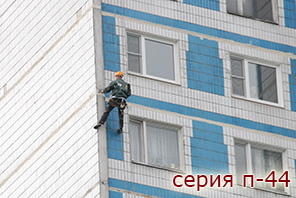
If there are damp, cold walls in the house and mold appears on them, smudges in the corners on the wallpaper and walls, drafts walk, freeze walls and heat is lost - it’s time to warm the house!
In order to eliminate recalculation difficulties, our company made a decision and “froze” the prices for the services provided, and as of May 2016 the prices remained the same as they were in 2015.
The cost of repairing interpanel seams depends on the type of house and the characteristics of the building, on average, from 350 rub. for pog. m. with all costs (material, work, coordination) We do not have any additional costs for the customer and an increase in cost! The minimum amount of work is at least 30 meters). Storeys do not affect the cost of work.Interpanel joints are sealed around the perimeter of the panel (upper, lower and side panel seams). For the last floor, another technical floor is added (as through the voids in the joints of the technical floor, water flows into the interpanel seams of your apartment). For block buildings, the volume of work is approximately 30% more.
If you know the type of house, then on the calculator, if you select the proposed parameters, you can accurately calculate the amount of work:
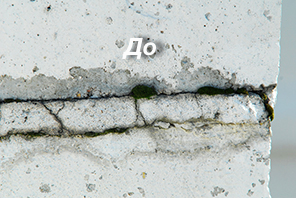

The main thing is not the chosen technology for seam repair, but the quality of materials and the experience of specialists.